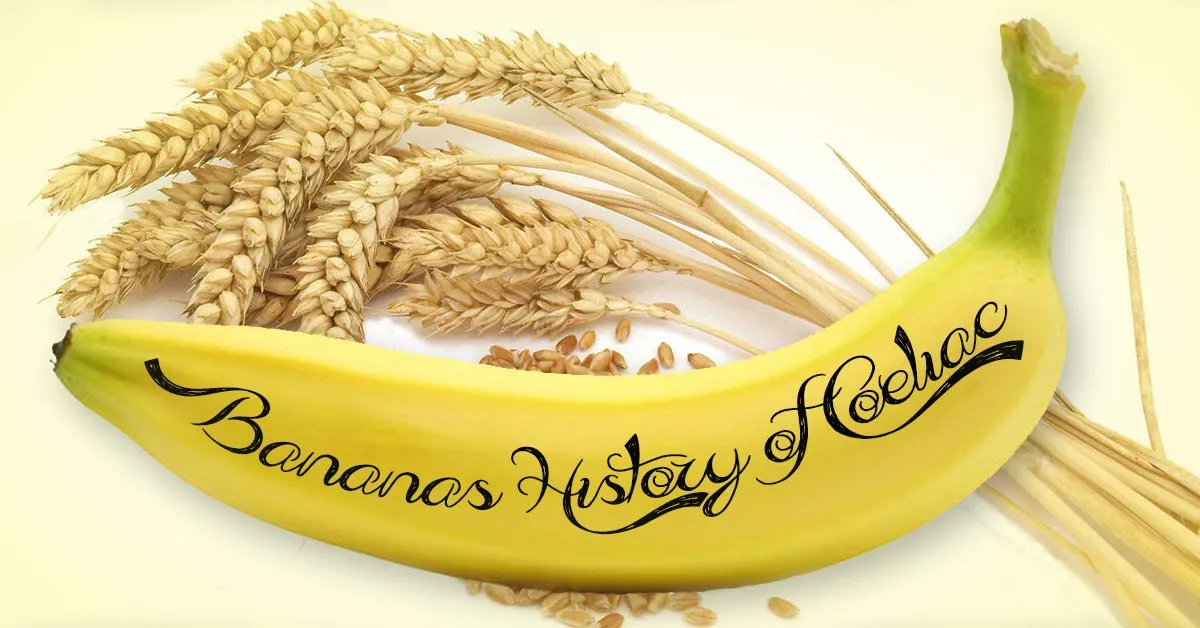Banana's History of Coeliac
Back to all blogs.It's kind of fascinating to look back on the history of Coeliac and it's progression through the ages, it's nothing new like some people think!
Last updated 10th November 2020
Published 15th May 2015

In todays society we have it easy living on a gluten free diet, with all the gluten free products now on the market, and with many restaurants catering to our dietary needs it is simple to eat an exciting and nutritious meal as well as enjoy treats such as cake and biscuits, but back in the early 20th century things were far from easy.
A disease called "koilakos" meaning "suffering in the bowels" was referred to back in 250AD, this is believed to be the earliest report of Coeliac. In 1884 Dr Louis Duhring saw the first case of the skin representation of Coeliac Disease, Dermatitis Herpetiformis. The 1900's also saw Samuel Gee refer to adults and children suffering with diarrhoea and fatigue as suffering from the "Coeliac affection".
In 1924 a New York doctor, Sidney Haas, believed you could successfully treat children with Coeliac using the Banana Diet. Many children were sent to him on the brink of death, countless operations revealed nothing and children were given hours to live when their parents turned up at the doctors with painfully thin children suffering swollen stomachs and sunken eyes.
At the time it was widely believed that carbohydrates and sugars were the cause, but the starch in bananas was tolerable to suffers, the Banana Diet consisted mostly of albunim milk, pot cheese, oranges, apples, dates, vegetables, gelatin, meat and of course bananas, between 4 to 8 bananas were eaten by suffers everyday.
After a few years on the diet, sugars would be reintroduced and the sufferers found that they could tolerate them when reintroduced slowly and the stomach got used to them, at the time they and the doctor believed the diet had cured them of Coeliac.
By the mid 1940's when bread was short during the war it was noticed that the health of children suffering from Coeliac was beginning to improve, by the end of the 1940's/ealry 1950's it was recognised that wheat gluten was the cause, not sugars and starches, and a gluten free diet was slowly introduced to Coeliacs rather than the Banana Diet. People advised to go on the Banana Diet during the war saw bananas added to their ration books, with children in towns receiving banana from local greengrocers while their non coeliac friends and family weren't allowed them due to how scarce they had become.
Many on the Banana diet started to become lactose intolerant due to the amount they were eating plus gluten not being removed so unbeknown to sufferers back then, the bread they were still allowed to eat was causing more harm to their bodies and the bananas not actually "curing" them. Sufferers were also being to find raw fruit and veg hard to digest and bananas starting to cause pain.
The removal of gluten to Coeliacs diets in the 1950's began to see sufferers tolerate lactose again and raw fruits and veg easy to digest once more, plain biscuits and tinned gluten free bread were prescribed and a basic diet of fruit, vegetables and naturally gluten free products was usually followed due to the lack of "manufacturered" items such as biscuits, cakes, bread and pasta we see plenty of nowadays.
In the 1950's Coeliac diagnosis' quadrupled, with bread steadily becoming available again on the market, more people started showing symptoms once they started eating it again, and due to the greater understanding that it is actually gluten causing the symptons, a gluten free diet was now recommended and not the Banana Diet that others had been on previously, and sufferers symptoms dramatically improved. The 1950's also saw development of biopsy's to more accurately diagnose Coeliac, a small sample of the intestine lining was taken, same as today, in order to identify damage.
During the 1950's there was only one producer of gluten free food, Welfare Food' Rite Diet, their tinned gluten free bread, which was just about bearable toasted, was the only form of gluten free bread you could get, unless you could get your hands on some gluten free flour of course, you could get a plain biscuit on prescription but they were hard and often broke teeth, apparently they were very remeniscent of baby rusks.
The blood test which is the first method of diagnosis used today wasn't developed until the 1970's when it was identified that specific antibodies are produced as an autoimmune response to gluten. Like the biopsies this tTGA (Transglutaminase Antibodies) blood test is still in use today, but remains slightly more inaccurate than the biopsy. By 1990 confirmation of diagnosis could only be confirmed by a positive blood test followed by a biopsy.
These days we are lucky, I can't imagine living on a gluten free diet back in the 1950's, now we have access to many manufacturered, yet high sugar products easily accessible in supermarkets. We don't have to live on a resticted diet where we can't eat sweets because doctors think sugar is the cause of Coeliac, and even better we don't have to live on 8 bananas a day and think we are being "cured". As time passes more products come available, no more tinned tasteless bread or rock hard biscuits instead we are seeing gluten free ready meals appearing nearly as much as gluten containing, and a wide variety of treats on the market with new ones appearing all the time.
Despite a basic diet of fruit, vegetables and naturally gluten free produce probably being the best way to live as it excludes the unnecessarily high sugar levels and pointless additives, when you think about it the amount available is far superior to what it was even back a few years ago. If you don't feel like cooking you can fairly easily grab a ready meal, back 10, 20, 50 years you didn't have that choice, you had to cook, if you wanted to eat, you had no choice.
I hear people moaning about being diagnosed with Coeliac, moaning they can't eat something they ate just last week, sit back and think about how people back in the 70's must have felt... if you were lucky enough to even get a proper diagnosis then because the blood tests and biopsies were only starting to be used. Junk food was starting to become the norm then, and you couldn't eat it once diagnosed because of the gluten in it, and you definitely couldn't get a gluten free alternative, think about how you would have coped then, maybe you would try and come up with your own alternative at home or just do without, whichever choice you can't deny just how far both diagnosis techniques and gluten free food have come over the years, and will continue to improve. Who knows in 50 years, maybe gluten free will be the norm and it will be hard to find gluten products anyway, Coeliac is becoming so pronounced in todays society, that's a theory that possibly isn't too far fetched.

Your Comments
Submit Comment
Want to leave a comment on this blog? Feel free to join the discussion!